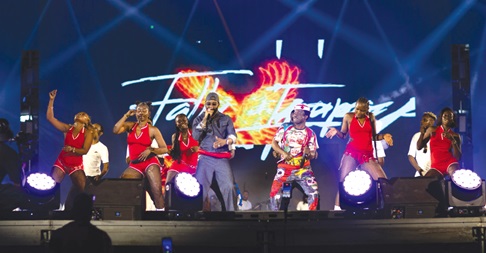This week, the city of Kinshasa saw and witnessed a pulsating blend of rhythm, colour and celebration.
The forecourt of the National Assembly, known affectionately as the People’s Palace, was transformed into a musical arena for three nights of pulsating musical extravaganza at the maiden edition of the World Music and Tourism Festival – a landmark event that has not only shaken the ground with sound but also stirred hearts and minds across borders.
On Wednesday night, a sea of jubilant Congolese fans stood shoulder-to-shoulder, waving flags and mobile phone flashlights, singing choruses and dancing with an energy that was nothing short of contagious.
Fally Ipupa, the global Rumba icon, set the bar high, delivering a mesmerising set full of elegance and urban edge.
He was joined by a host of performers who brought their A-game – blending Rumba with tradition, pop with poetry and nostalgia with now.
The crowd? Unstoppable.
Every note, every beat, every drumroll was met with thunderous applause and dancing that spilt well into the Kinshasa night.
As I write this piece on Thursday evening, the energy seems to be rising again with anticipation of performances from Werrason, Zaiko Langa Langa, Mbilia Bel, Chœur MC, Innos’B, DJ Queeny and others.
The denouement will be another big night on Friday, featuring the legendary Koffi Olomide and a cross-continental cast of artists such as Sam Mangwana (Angola), Jacques Tshimankinda, RJ Kanyera, Ballet Longo, and DJ Numerator. But make no mistake: this is not just a series of concerts. This is a cultural statement, wrapped in rhythm and backed by a bold vision for Congo and Africa.
Launched on Wednesday by President Félix Antoine Tshisekedi Tshilombo, with UN Tourism Secretary-General Zurab Pololikashvili and Secretary-General-elect Shaikha Al Nowais in attendance, the festival, which was organised by the Government of the Democratic Republic of Congo, in collaboration with UN Tourism, has served as a vibrant fusion of art, diplomacy, policy and celebration.
In the words of Pololikashvili during the launch, “both music and tourism are instruments of peace. They break down barriers, foster understanding and remind us of our common humanity.
This festival shows what African tourism can be – inclusive, authentic and proudly rooted in culture.”
Let’s talk about four key takeaways – four gifts this maiden festival has offered the DRC, the African continent and the world.
A Celebration of Cultural Power and National Identity
In a country often discussed through the prism of its vast mineral resources or security challenges, the festival boldly shifted the spotlight to Congo’s true, enduring wealth: its people and its culture.
The vivaciousness and ebullience of the Congolese people at every concert and mini-event have been electric. Streets are draped in festival branding.
The Cultural Village is alive with music, smells of local food and the sounds of spontaneous dance.
You can feel the pride, not forced or formal, but genuine, exuberant, unfiltered joy.
This is a people who know their music is a gift to the world.
And indeed, Congolese Rumba, declared a UNESCO Intangible Cultural Heritage in 2021, is more than music – it's history set to rhythm. It’s a living language of love, resistance, storytelling and pride. This week, the world didn’t just hear it – they experienced it in full colour.
Music as a Strategic Driver of Tourism
With the theme: “The Rumba Route for Peace”, the festival rightly placed music at the centre of Congo’s tourism and soft power strategy. Kinshasa has become a big stage – from the Central African Cultural and Arts Centre (CCAPAC) through the Cultural Village to the People’s Palace – where culture is experienced, not just consumed.
Panels, such as “Music at the Heart of Tourism”, underscored the role of musical heritage in branding destinations.
From reggae in Jamaica to Afrobeats in Nigeria, the world already travels for music.
Why not Rumba in Congo? With the right infrastructure and international partnerships, the DRC can create entire cultural itineraries for tourists seeking music, memory and movement.
A Forum for Policy, Rights and Creative Economies
One of the festival’s most commendable elements has been its serious intellectual and policy dimension.
The Fair Play roundtables and masterclasses tackled crucial questions around copyright, artists’ rights, remuneration and the balance between culture and commerce.
Experts from WIPO, ARIPO and music professionals from across Africa, Europe and Latin America engaged in deep conversations about how to protect creators while fostering innovation.
For a continent where many artists still struggle with ownership and fair compensation, these sessions were not just symbolic – they were critical.
A Model for Continental Collaboration and Cultural Diplomacy
With participation from ministers, creatives and cultural leaders from Ghana, Côte d’Ivoire, Colombia, Argentina, Zimbabwe, South Africa and more, the festival wasn’t just about Congo.
It was about Africa. It was about the diaspora and it was about how music can connect regions, generations and histories.
Sessions like “Transatlantic Rhythms for Peace” reminded us that music has always travelled, and so have we.
The rhythms of Rumba are heard in Havana, in Rio, in New Orleans.
And today, they’re calling the world back to Kinshasa.
The first World Music and Tourism Festival has been more than an event. It has been a cultural renaissance.
One led not by policy papers or campaigns, but by the pulse of the people.
By the sound of drums.
By the sway of hips.
By the chorus of generations singing together in the country that positions and prides itself as the “Centre of Africa”.
Congo is dancing again. And this time, the whole world is watching.

